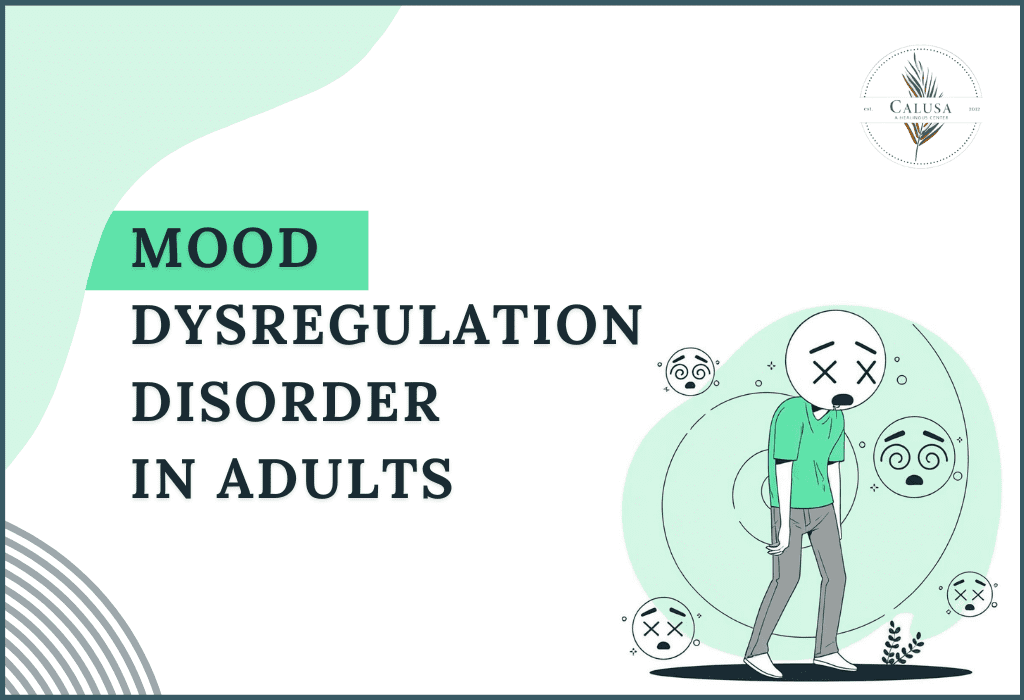Living with intense emotions that feel out of control can make even simple daily tasks overwhelming. For adults with mood dysregulation disorder, this struggle is a constant reality. This condition doesn’t just affect how someone feels. It influences relationships, work performance, and overall mental health.
Calusa Recovery understands how exhausting this can be. With a focus on comprehensive and compassionate care, we aim to help individuals regain control over their emotions and improve their quality of life. Let’s explore what mood dysregulation disorder is, its symptoms, and how to find an effective solution that works.
Is your mental health standing in the way of a better life?
What is Mood Dysregulation Disorder?
Mood dysregulation disorder is a mental health condition characterized by intense emotional reactions that are difficult to manage. Unlike occasional mood swings, this disorder involves a chronic struggle with emotional regulation, making it hard to navigate stress or maintain healthy relationships.
The Research highlights that mood disorders affect approximately 21.4% of U.S. adults at some point in their lives, significantly impacting emotional regulation and daily functioning.
Understanding this condition is the first step in finding the right support and solutions.
Symptoms of Mood Dysregulation Disorder in Adults
The symptoms of mood dysregulation disorder in adults exhibit a range of symptoms that can, however, be severely disruptive. Early identification of these symptoms can assist in seeking appropriate management options.
As these symptoms are generally easy to recognize, here are some of the red flags that suggest a person has this disorder:
- Outbursts of emotions: A pervasive anger or sadness that a person struggles to control, even when he wishes to do so.
- Persistent irritability: Chronic annoyance is mostly evident without a specific cause.
- Difficulty managing stress: Overreacting to even simple stress disorders.
- Emotional volatility: Emotional extremes experienced suddenly and unexpectedly.
- Difficulties in a relationship: Obstacles or multiple disputes arising from uneven emotions.
If you recognize even one of the previous key symptoms, there is no need to consider it your lifestyle. Help is always available for mood dysregulation disorder in adults, and with the right support, a person can lead a happier and healthier life.
Causes of Mood Dysregulation Disorder in Adults
Intense emotional distress is not a pleasant experience for anyone. Just like any other psychological disorder, the Causes of this disorder are multifactorial, associated with genes, environment, or personal history.
It is possible to develop sufficient knowledge of the underlying aetiological factors, which will be crucial in treatment. Some of these elements often contribute to the disorder.
- Genetic risk factors: Owing to the heritability of affective illness, these two tend to reinforce one another.
- Brain chemistry: People who have suffered this setback often have low amounts of one or both of these neurotransmitters, including serotonin and dopamine, in their brains.
- Trauma: Many child-related issues, such as neglect and unauthorized childhood abuse, all fall under the umbrella of a bad childhood experience.
- Chronic stress occurs when a person is always in a stressful environment, either at work, at home, or in a long-term relationship.
Conceding these sources is not about assigning blame; it is about being able to see clearly. Understanding the ‘why’ of factors that contribute to children with mood dysregulation disorder in adults lets one understand the ‘how’ of the solution in all aspects of help-seeking.
Solutions for Mood Dysregulation Disorder in Adults
Finding solutions for mood dysregulation disorder in adults means embracing a combination of professional care and personal effort. Recovery doesn’t happen overnight, but every step forward is a step toward freedom from emotional overwhelm.
Professional Treatment Options
The most appropriate method of treatment for this condition is usually through professional care providers.
Given these, what evidence-based approaches do you recommend for adults with mood dysregulation disorder?
- Therapy: Methods such as cognitive behavioral therapy (CBT) to remember their coping strategies and know what triggers help the situation. Around 25-30% of individuals diagnosed with mood disorders benefit most from a combination of medication and evidence-based therapies like CBT or DBT.
- Medication: It is often the case that those medications, together with antidepressants or mood stabilizers, doctors give help bring emotions back to something normal.
- Mindfulness practices: People should practice meditation and, more importantly, relaxation techniques. This brings about a normal state and clarity of the mind.
If you’ve never considered working with professionals in the field of health and wellness, it’s about time you went for it! These specialists are capable of making all the following changes possible, and there are many more than just the two that are outlined for you below: holistic approach, professional help, and healthy lifestyle.
Lifestyle Adjustments
Along with professional care, adherence to a healthy lifestyle can further boost emotional resilience.
More than 50% of adults diagnosed with mood dysregulation have a history of childhood emotional issues, highlighting the importance of early intervention.
Lifestyle modifications can significantly help while treating adult mood dysregulation mood dysregulation disorder in adults:
- Exercise regularly: Develops a favorable effect on mood as endocrine release endorphins.
- Maintain a sleep routine: Calm emotions are usually achieved through sound sleep of adequate duration.
- Practice self-care: Whenever possible, do what feels good.
Although seemingly trivial, these interventions can maximize the effects of therapy and medications, making it easier to live a productive and satisfying life.
How to Support Someone With Mood Dysregulation Disorder in Adults
Supporting an adult with mood dysregulation disorder can make a lasting difference to the individual.
A longitudinal study found that 70% of adults with mood dysregulation disorders report difficulties maintaining long-term personal and professional relationships without therapeutic intervention.
Here’s how you can help someone you love in an effective way:
- Be understanding: Never expect too much in a short time. Offer encouragement as needed.
- Advocate for them: If they appear to be receptive, recommend that they seek professional assistance.
- Support their feelings states: It’s fine to feel whatever it is they’re feeling.
Your empathy can play a critical role for someone who is fighting this battle. You can create an environment of healing and improvement together, that feels possible.
Your Journey to a Brighter Tomorrow
Conclusion: It’s Time to Find Balance And Well-Being.
Mood dysregulation disorder in adults creates a lot of issues; however, it is good to know that there is help available. It takes a lot of impetus to take the first step in the journey of recovery.
At Calusa Recovery, we believe in holistic care that addresses the mind, body, and spirit. Our team is here to provide personalized, compassionate support to guide you toward a brighter future.
Are you ready to take charge and improve your mental health? Contact us today and put up the first steps towards achieving balance and focus in your life.
FAQs
Q: What are the symptoms of mood dysregulation?
A: Symptoms of mood dysregulation include intense emotional outbursts, chronic irritability, difficulty managing stress, frequent mood swings, and challenges maintaining relationships. These symptoms significantly impact daily functioning and emotional well-being.
Q: What does emotional dysregulation look like in adults?
A: In adults, emotional dysregulation appears as sudden anger, sadness, or frustration, difficulty calming down, impulsive reactions, and an inability to cope with minor stressors. It often disrupts relationships, work, and overall quality of life.
Q: What does DMDD turn into as an adult?
A: Disruptive Mood Dysregulation Disorder (DMDD) in adulthood can develop into conditions like depression, anxiety, or borderline personality disorder. Early intervention and treatment can reduce the long-term effects and improve emotional regulation.
Q: What is the best treatment for disruptive mood dysregulation disorder?
A: The best treatment for DMDD includes therapy, such as cognitive-behavioral therapy (CBT), mindfulness practices, and medication. These approaches help manage symptoms, regulate emotions, and improve overall quality of life.










